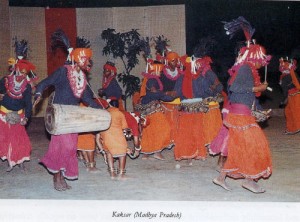
The Abuj-Maria tribal community perform an interesting dance known as Kaksar. Actually, Kaksar is a deity who is worshiped before the rains for a rich harvest. It is, however, different from the other harvest dances discussed earlier, because, according to the tradition, while the boys and girls are dancing they choose their partners for life. The marriage is solemnized later. The boys wear a fascinating costume that includes a belt of large number of big and small jinglebells (ghungroo) tied to the back side of their waist. When they dance the sound of the jingle bells enhances the appeal of the percussion music of the dance. The girls hold in their right hand waist-high iron rods having a few jinglebells on the top. While dancing they sing and strike the iron rod vertically on the ground on the accented beats of the rhythm. This sound blends well with that of the jingle bells worn by the boys. The girls form a semicircle and each dancer holds the iron rod in her right hand and the waist of nearest dancer with the left hand. The boys form a semicircle in front of the girl group. Both move in circles. While Mandar and Timki provide the percussion music, Bansuri, the flute provides the melodic component of the accompanying music.
